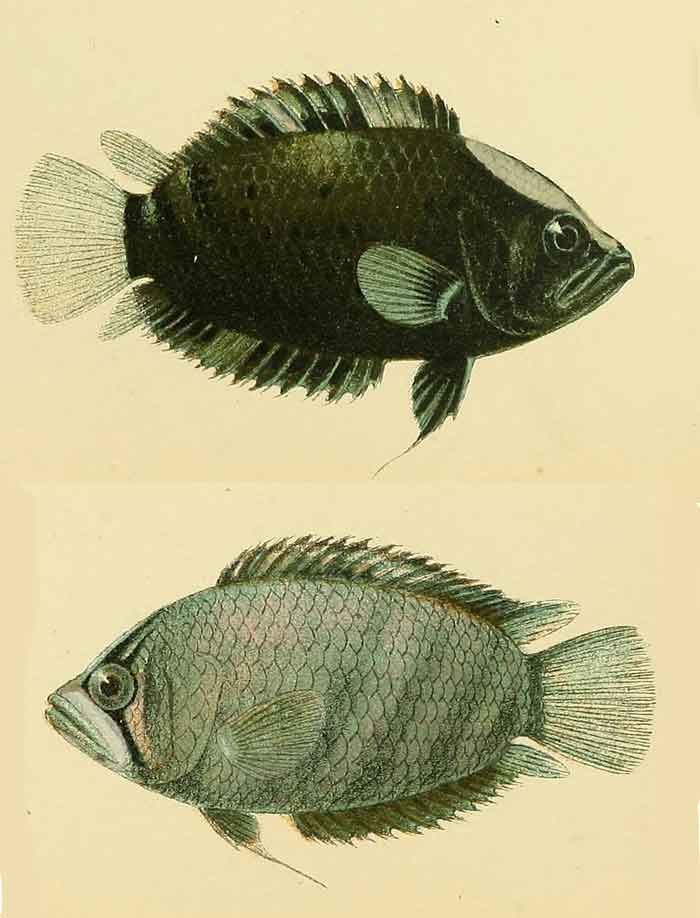
Superregnum: Eukaryota
Cladus: Unikonta
Cladus: Opisthokonta
Cladus: Holozoa
Regnum: Animalia
Subregnum: Eumetazoa
Cladus: Bilateria
Cladus: Nephrozoa
Superphylum: Deuterostomia
Phylum: Chordata
Subphylum: Vertebrata
Infraphylum: Gnathostomata
Megaclassis: Osteichthyes
Superclassis/Classis: Actinopterygii
Classis/Subclassis: Actinopteri
Subclassis/Infraclassis: Neopterygii
Infraclassis: Teleostei
Megacohors: Osteoglossocephalai
Supercohors: Clupeocephala
Cohors: Euteleosteomorpha
Subcohors: Neoteleostei
Infracohors: Eurypterygia
Sectio: Ctenosquamata
Subsectio: Acanthomorphata
Divisio/Superordo: Acanthopterygii
Subdivisio: Percomorphaceae
Series: Ovalentaria
Familia: Polycentridae
Genus: Polycentrus
Species: Polycentrus schomburgkii
Name
Polycentrus schomburgkii Müller & Troschel, 1849
Syntypes: ZMB 1024 (2), 20604 (ca. 30).
Type locality: Essequibo River, Guyana.
Synonyms
Labrus punctatus Linnaeus, 1758
Polycentrus tricolor Gill, 1858
Mesonauta surinamensis Sauvage, 1882
Opinion 1954 in June 2000 established that Polycentrus schomburgkii is to be given precedence over the name punctatus Linnaues 1758 whenever the two names are considered to be synonyms. On the Official List of Generic Names in Zoology.
References
Linnaeus, C. 1758. Systema Naturae per regna tria naturæ, secundum classes, ordines, genera, species, cum characteribus, differentiis, synonymis, locis, Tomus I. Editio decima, reformata. Holmiæ: impensis direct. Laurentii Salvii. i–ii, 1–824 pp DOI: 10.5962/bhl.title.542: 285. Open access Reference page. (Labrus punctatus)
Opinion 1954: Labrus Linnaeus, 1758, Cichlasoma Swainson, 1839 and Polycentrus Müller & Troschel, 1848 (Osteichthyes, Perciformes): conserved by the designation of Labrus mixtus Linnaeus, 1758 as the type species of Labrus and L. bimaculatus Linnaeus 1758 as the type species of Cichlasoma; and Polycentrus schomburgkii Müller & Troschel, 1849: specific name given precedence over L. punctatus Linnaeus, 1758. Bulletin of Zoological Nomenclature v. 57, pt. 2 (2000):131. BHL
Müller, J. & Troschel, F. H. 1849. Fische (pp. 618–644). In: Reisen in Britisch-Guiana in den Jahren 1840–44. Im Auftrag Sr. Mäjestat des Königs von Preussen ausgeführt von Richard Schomburgk. [Versuch einer Zusammenstellung der Fauna und Flora von Britisch-Guiana.] 3. Berlin. DOI: 10.1017/CBO9780511782916Reference page.
Reis, R.E., S.O. Kullander and C.J. Ferraris, Jr. (eds), 2003. Check list of the freshwater fishes of South and Central America. CLOFFSCA. EDIPUCRS, Porto Alegre. 2003: i-xi + 1-729
Links
Polycentrus schomburgkii in the World Register of Marine Species
Polycentrus schomburgkii in Catalog of Fishes, Eschmeyer, W.N., Fricke, R. & van der Laan, R. (eds.) 2024. Catalog of Fishes electronic version, accessed on June 06, 2021.
Polycentrus schomburgkii in FishBase,
Froese, R. & Pauly, D. (eds.) 2024. FishBase. World Wide Web electronic publication, www.fishbase.org, version 02/2024, accessed on June 06, 2021.
Polycentrus schomburgkii – Taxon details on Integrated Taxonomic Information System (ITIS).
Polycentrus schomburgkii – Taxon details on National Center for Biotechnology Information (NCBI).
Vernacular names
čeština: Ostnáč Schomburgkův
Deutsch: Südamerikanischer Vielstachler
English: Guyana leaffish
polski: Wielocierń
português: Marajó
ไทย: ปลาใบไม้กายอานา
українська: Риба-обрубок
Polycentrus schomburgkii, also known as the Guyana leaffish is a species of fish belonging to the family Polycentridae. It inhabits fresh and brackish waters, both clear and turbid, of the northeastern part of South America and Trinidad. It reaches a maximum length of 5.5 centimetres (2.2 in).[1]
Description
The females are a deep brown, but the males are velvety-black with turquoise or silver spots and flecks. It uses its coloration to blend in with its surroundings.
In the aquarium
Polycentrus schomburgkii is sometimes kept as an aquarium fish, where its small size allows for tanks as small as ten gallons in size. Like other South American leaffishes (and numerous other leaf-like fishes, for that matter) it is an ambush predator that floats motionless among plants until a smaller fish swims close enough for it to swallow.[2] Because of its predator nature, its tank mates should be large enough to avoid being eaten; however, they also should not be vigorous enough to outcompete the leaf fish for food. These fish are known to be difficult aquarium inhabitants, requiring live foods such as small fish, bloodworms, and brine shrimp; they seldom adapt to a more prepared diet; further, they need soft, acidic, very clean water.
Spawning in the aquarium is known to be challenging. These fish spawn in a cave, often in a leaf, and the male guards them for 3 to 4 days before they become free swimming. The fry are well known for being very cannibalistic when poorly fed and are even more sensitive to sub par water quality than the parents.[3]
References
Froese, Rainer; Pauly, Daniel (eds.). "Polycentrus schomburgkii". FishBase. August 2013 version.
Britz, R. and S.O. Kullander, 2002. Polycentridae (Leaffishes). p. 603-604. In R.E. Reis, S.O. Kullander and C.J. Ferraris, Jr. (eds.) Checklist of the Freshwater Fishes of South and Central America. Porto Alegre: EDIPUCRS, Brasil.
"Guyana Leaffish - Polycentrus schomburgkii." Guyana Leaffish - Polycentrus schomburgkii. N.p., n.d. Web. 31 Aug. 2013.
Retrieved from "http://en.wikipedia.org/"
All text is available under the terms of the GNU Free Documentation License

